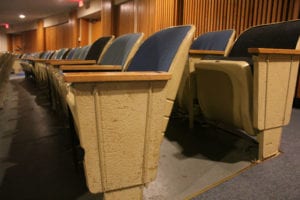
The results are in, and Port Jefferson School District teachers, administrators and students have plenty to be proud of.
Jessica Schmettan, the district’s executive director of curriculum and instruction, presented data regarding Port Jeff students scores on Advanced Placement tests taken in May 2017 during a Dec. 12 board of education meeting. AP is a program that offers college-level curriculum and exams to high school students, and college credits are available based on performance in the courses. The College Board, a nonprofit formed to expand access to higher education in North America, created the AP program. The exams are scored from 1 to 5, with scores 3 or higher considered proficient and a minimum standard to be able to earn college credit.
Participation in AP courses and performance on exams overall are trending up in Port Jeff. In 2017, Port Jeff students took 354 AP exams, compared to 280 in 2015. Schmettan said the district was proud to see the increase in the number of students taking the exams and expects that number to increase as more AP offerings are made available to students.
PJSD superintendent, board discuss future after bond fails
By Alex Petroski
Port Jefferson School District superintendent, Paul Casciano, and board of education president, Kathleen Brennan, each made public comments Dec. 12 regarding the future of capital improvement projects that would have been addressed by a $30 million bond, a proposal that was voted down by a wide margin by district residents Dec. 5.
Casciano: “Our capital bond proposal was defeated [Dec. 5]. Our board of education and administration are in the process of reviewing what implications there are in the results to determine which steps would be in the best interest of our students. Although we’re disappointed by the outcome, we are grateful that so many residents took the time to vote. Our discussions moving forward will be focused on how best to address the problems that we are facing, namely the health, safety and security of our students and staff; compliance with state and federal regulations; our aging infrastructure; and our overcrowded and overtaxed athletic fields. Hopefully at some point in the future we’ll actually get to plan how to transform our instructional settings into a 21st-century learning environment.”
Brennan: “This is our first board meeting since the vote, so clearly we had no time to discuss the outcome among the board members. I can assure you that we hear you, we heard the vote from the public, and we plan to study that and clearly and carefully and slowly move forward. We certainly will include the public in those plans. So I thank you for your comments and your interest in our district.”
“It is gratifying to see the number of our students [taking AP courses] continuing to grow and the offerings in AP,” board of education member Mark Doyle said during the meeting.
The mean score for Port Jeff students increased when comparing 2016 results to 2017 results on exams in 13 subject areas, including chemistry, environmental science, world history and calculus. In each of those particular subjects, more than 90 percent of students taking the test scored a 3 or better. In addition, the mean Port Jeff 2017 scores in 14 subject areas exceeded the New York State means. In environmental science and chemistry, the Port Jeff means were more than a full percentage point better than New York State means. Schmettan said she was impressed to see the 2017 chemistry scores as the district mean was 4.00, compared to 2.90 across the state and 3.13 in 2016 in Port Jeff.
Average scores in English language and composition, English literature and composition, world history, and U.S. history all went up from 2016 to 2017. However, AP calculus scores skyrocketed in 2017, jumping from 2.57 on average last year to 4.15, which represented the largest increase in any subject.
“We saw a very strong comeback in AP calculus, and we’re proud of that,” Schmettan said.
In another area of mathematics, statistics, 2017 test takers struggled compared to last year. The average 2016 score was 3.92, compared to 3.05 this past May.
“We’re hoping that is a similar event as to what happened in AP calculus last year, that perhaps it is an event not a pattern in the data,” she said.
Port Jeff came in below other New York State test takers on average in five subjects: macroeconomics, biology, Spanish language and culture, music theory and computer science. Biology scores have come down from a mean of 3.19 in 2014 to a 2.92 in 2017.
In total 29 students in Port Jeff were named AP Scholars with Distinction, which is granted to test takers who receive scores of at least 3.50 on all exams taken and scores of 3 or better on five or more exams. Six students were named National AP Scholars for earning a 4 or better on all tests taken and at least a 4 on eight or more exams.
“This is something that we should very much be proud of in Port Jefferson,” Schmettan said.
Visit www.portjeffschools.org to see the full results and click on “Curriculum & Instruction” under the “Departments” tab.























